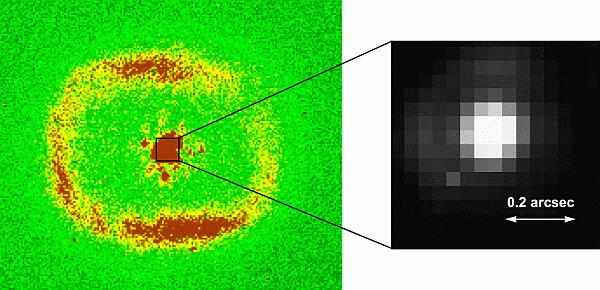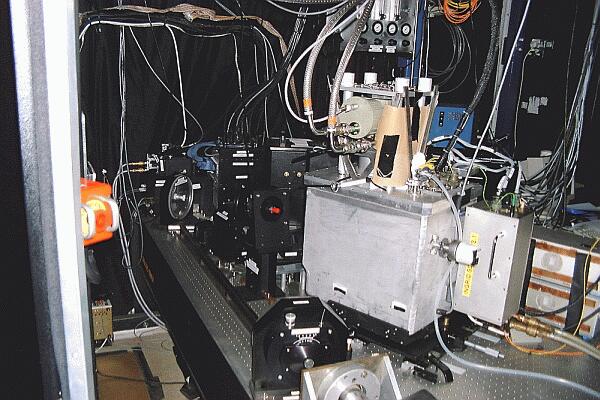| THE ING NEWSLETTER | No. 4, March 2001 |
|
|
THE ING WIDE FIELD IMAGING SURVEY | SCIENCE |
|
|
|
| Previous: | Normal and Eccentric Dying Suns | Up: | Table of Contents | Next: | Extragalactic Planetary Nebula Kinematics with the WHT |
Other available formats: PDF | gzipped Postscript
NAOMI – Adaptive Optics at the WHT
Chris Benn (ING), Andy Longmore (ATC), Richard Myers (Univ. of Durham), Tom Gregory (ING), Clive Davenhall (IoA)
NAOMI
is mounted at the WHT's GHRIL Nasmyth focus, and delivers near-diffraction-limited
images, FWHM  0.2 arcsec, to the IR camera INGRID. NAOMI had its first
commissioning run in August/September 2000. An image from that run is shown
in Figure 1. Most of the remaining commissioning
work will be completed off-sky before the May/June 2001 commissioning nights,
which will be used principally for characterising on-sky performance.
0.2 arcsec, to the IR camera INGRID. NAOMI had its first
commissioning run in August/September 2000. An image from that run is shown
in Figure 1. Most of the remaining commissioning
work will be completed off-sky before the May/June 2001 commissioning nights,
which will be used principally for characterising on-sky performance.
 |
| Figure 1. On the left: a 90-sec K-band commissioning image of planetary nebula BD 303369 (nebula diameter 3.8 arcsec top to bottom). The blobs around the central (guide) star are ~1% residuals in the PSF. On the right: enlargement of area around the central star, FWHM 0.13 arcsec. Parts of the first diffraction ring are just visible. [ JPEG | TIFF ] |
NAOMI/INGRID is offered in semester 2001B on a shared-risks basis, for the period August – November 2001 (other instruments will be mounted on the GHRIL Nasmyth platform during December and January). The observing will be carried out in service mode. NAOMI can be used to image any astronomical target which has a suitable guide star nearby. AO systems at other large telescopes (CFHT, Gemini, Keck I) have been used to study a wide variety of objects, including comets, binary asteroids, circumstellar disks, dwarf galaxies, AGN, QSO hosts and gravitational lenses.
Table 1
shows predictions (based on models by Ron Humphries and Richard Wilson,
Durham) of NAOMI's performance as a function of guide-star magnitude, wavelength
band and uncorrected seeing. Performance is given in terms of 'Strehl
ratio', the ratio between the peak heights of the corrected and diffraction-limited
point-spread functions.
|
|
|
|
|
||
|
|
|
|
|
||
|
|
|
|
|
|
|
|
|
|
|
|
|
|
|
|
|
|
|
|
|
|
|
|
|
|
|
|
|
|
|
|
|
|
|
|
|
|
|
|
|
|
|
|
|
|
|
|
|
|
|
|
|
|
|
|
|
|
|
|
|
|
|
|
|
|
|
|
|
|
|
|
|
|
|
|
|
|
|
|
|
|
|
|
For Strehl ratios of more than a few tenths, the bulk of the light will be concentrated in a diffraction-limited core (FWHM ~0.12 arcsec in K), with the remainder of the light distributed over the (uncorrected) natural-seeing disk. With poorer AO correction, there will still be a diffraction-limited core, but it will contain only a small fraction of the light.
Strehl ratio is predicted to fall to half its on-axis value at radii 13, 17 and 23 arcsec respectively in J, H and K bands (the size of the anisoplanatic patch scales as wavelength6/5). That is, for a given degree of correction, the guide star needs to be closer to the target for J and H imaging than for K. The sky coverage, i.e. the fraction of sky falling within the anisoplanatic patch of a bright star, depends on required Strehl, and on galactic latitude. In K band, for delivered Strehl 0.3, sky coverage is ~10% at galactic latitude 30°.
The guide star can be the target
itself, if sufficiently bright and pointlike (FWHM <1.5 arcsec). There
should be no stars of similar magnitude within ~5 arcsec of the guide star.
The scale at INGRID is 0.04 arcsec/pixel, field of view 40 arcsec. The
sky background in J and H is similar to that measured with INGRID mounted
at the Cassegrain focus. The K thermal background has yet to be determined
(see the ING NAOMI web
page for the latest information). Throughput to INGRID with NAOMI is
about 0.5 times that to INGRID mounted at Cassegrain (due to losses in
the GHRIL derotator, and in the NAOMI optics). Signal-to-noise predictions
can be made using SIGNAL, the ING signal-to-noise calculator.
 |
| Figure 2. NAOMI in GHRIL, during commissioning August and September 2000. The large box in the foreground is INGRID. [ JPEG | TIFF ] |
Observing overheads with adaptive-optics systems are higher than for normal observing. For acquisition of the guide star by the wavefront sensor, observers should allow 5 – 10 minutes per target. Additional time should be allowed for calibration of the point-spread function (PSF), if required. The PSF delivered by an AO system is a function of radius from the guide star, but can be estimated by observing star pairs of similar separation (to the guide star and target) at frequent intervals during the night (~every half hour). For extended targets, offset sky exposures will also be required (as for normal IR observing). INGRID itself takes only ~1 sec to read out.
With planned enhancements to the way the wavefront-sensor CCDs are read, the eventual guide-star limit for NAOMI will be ~1 mag fainter than quoted in Table 1. In the longer term, the use of 'zero-noise' CCDs in the wavefront sensor offers another potential gain. Each 1-mag increase in the guide-star limit corresponds to a factor of 3 increase in sky coverage.
NAOMI currently feeds only the IR imager INGRID, but its real strength, compared with other AO systems, is expected to be its performance at shorter wavelengths. From late 2002 NAOMI will feed the integral-field optical spectrograph OASIS (formerly at CFHT), and an optical imaging camera is also planned. A coronograph is being designed, and this will feed either the IR or optical imager (~spring 2002), or OASIS for spectroscopy (~spring 2003).
NAOMI has arrived ! Observers are encouraged to apply to use it in semester 2001B. For technical details, and further information on using NAOMI, see the ING NAOMI web page at http://www.ing.iac.es/Astronomy/instruments/naomi/index.html, or email one of the authors below.
Searching for NAOMI Guide Stars
Observations made with the NAOMI adaptive optics system usually require a guide star close to the target object. The NAOS package is available to assist in finding such guide stars. The user provides a list of target objects and NAOS remotely searches a version of the USNO PMM astrometric catalogue for suitable stars. NAOS is documented in the manual SUN/235, which comes with the package. NAOS will be included on the Starlink CD-ROM to be released in the summer of 2001. In order to make NAOS available immediately, a copy will be available in the Starlink Software Store no later than Monday 12 March 2001. In order to retrieve a copy from the Software Store go to URL:
http://www.starlink.rl.ac.uk/cgi-store/storetop
and follow the links 'full list
of available software' and 'Applications and User Interfaces'. Then click
on the entry for 'NAOS'. If you have queries about NAOS,
or encounter any difficulty in using it, please send an e-mail message
to: cursa@star.rl.ac.uk.
Email contacts:
Chris Benn (crb@ing.iac.es)
Andy Longmore (ajl@roe.ac.uk)
| Previous: | Normal and Eccentric Dying Suns | Up: | Table of Contents | Next: | Extragalactic Planetary Nebula Kinematics with the WHT |
| GENERAL | THE ING WIDE FIELD IMAGING SURVEY | SCIENCE | TELESCOPES AND INSTRUMENTATION | OTHER NEWS FROM ING | TELESCOPE TIME |